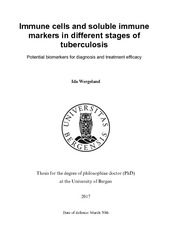| dc.contributor.author | Wergeland, Ida | en_US |
| dc.date.accessioned | 2017-06-07T07:38:15Z | |
| dc.date.available | 2017-06-07T07:38:15Z | |
| dc.date.issued | 2017-03-30 | |
| dc.identifier.isbn | 978-82-308-3102-1 | en_US |
| dc.identifier.uri | https://hdl.handle.net/1956/15932 | |
| dc.description.abstract | Tuberculosis (TB) is a major global health problem, especially in the developing world. In order to end the TB epidemic, reliable and rapid diagnostic tools that can identify and discriminate between latent and active TB are required. In addition, the emergence of multi- and extensively drug resistant strains of Mycobacterium tuberculosis (Mtb) highlights the need of improved treatment regimens and tools for monitoring the effect of treatment. It has been suggested that adjunct treatment that targets the host response to infection has the potential to facilitate eradication of Mtb, reduce tissue inflammation and shorten the treatment duration. The main aim of this thesis was to characterise immune cells and soluble immune markers in different stages of TB infection with focus on identifying potential biomarkers that may improve TB diagnostics and monitoring of treatment efficacy. The secondary aim was to explore the in vitro effects of the potential adjunct treatment option cyclooxygenase (COX)-inhibition on Mtb specific T cell responses. Peripheral blood mononuclear cells, plasma and supernatants from the QuantiFERON-TB Gold (QFT) test were obtained from individuals with active and latent TB before and during TB treatment and from QFT-negative controls. T cell subsets were studied by flow cytometry and potential immune modulating effects of the COX-inhibitor indomethacin on Mtb specific T cell responses were examined in vitro. Multiple soluble markers were measured in plasma and QFT supernatants by multiplex and enzyme immunoassays. In paper I, we found that the level of regulatory T cells (Treg) was higher in both the active and latent TB group compared with controls. The results of paper IV indicate that the COX-inhibitor indomethacin may be used to modulate the immune response in active TB by reducing the number of Mtb specific Treg. In paper II, we report that the plasma level of interferon gamma inducible protein 10 (IP-10), although not specific for TB, may differentiate between active and latent TB irrespective of human immunodeficiency virus (HIV) infection and may also be used to monitor the effect of treatment. In paper III, we did not find any marker with potential to differentiate between active and latent TB infection when Mtb specific marker levels were analysed in QFT supernatants. However, Mtb specific interleukin (IL)-1ra, IL-2 and IP-10 levels distinguished individuals with borderline QFT test results from QFT negative controls and these markers may improve the differentiation between latent TB and non-TB infected individuals. In conclusion, the results support that Treg may be a target for adjunct host directed therapy in TB, and that Mtb specific Treg can be reduced by COX-inhibitors which are well known drugs approved for other clinical conditions. Potential biomarkers for TB diagnosis and treatment efficacy have been identified. However, further studies are needed to examine whether it is possible to establish sufficient sensitive and specific test cut-offs for use in clinical practice. | en_US |
| dc.language.iso | eng | eng |
| dc.publisher | The University of Bergen | eng |
| dc.relation.haspart | Paper I: Wergeland I, Assmuss J, Dyrhol-Riise AM. T regulatory cells and immune activation in Mycobacterium tuberculosis infection and the effect of preventive therapy. Scand J Immunol. 2011 Mar;73(3):234-42. The article is available in the main thesis. The article is also available at: <a href="http://dx.doi.org/10.1111/j.1365-3083.2010.02496.x" target="blank">http://dx.doi.org/10.1111/j.1365-3083.2010.02496.x</a> | en_US |
| dc.relation.haspart | Paper II: Wergeland I, Pullar N, Assmuss J, Ueland T, Tonby K, Feruglio S, Kvale D, Damås JK, Aukrust P, Mollnes TE, Dyrhol-Riise AM. IP-10 differentiates between active and latent tuberculosis irrespective of HIV status and declines during therapy. J Infect. 2015 Apr;70(4):381-91. The article is available at: <a href="http://hdl.handle.net/1956/10300" target="blank">http://hdl.handle.net/1956/10300</a> | en_US |
| dc.relation.haspart | Paper III: Wergeland I, Assmuss J, Dyrhol-Riise AM. Cytokine patterns in tuberculosis infection; IL-1ra, IL-2 and IP-10 differentiate borderline QuantiFERON-TB samples from uninfected controls. PLoS One. 2016 Sep 29;11(9):e0163848. The article is available at: <a href="http://hdl.handle.net/1956/15930" target="blank">http://hdl.handle.net/1956/15930</a> | en_US |
| dc.relation.haspart | Paper IV: Tonby K, Wergeland I, Lieske NV, Kvale D, Tasken K, Dyrhol-Riise AM. The COX-inhibitor indomethacin reduces Th1 effector and T regulatory cells in vitro in Mycobacterium tuberculosis infection. BMC Infect Dis. 2016 Oct 24;16(1):599. The article is available at: <a href="http://hdl.handle.net/1956/15931" target="blank">http://hdl.handle.net/1956/15931</a> | en_US |
| dc.title | Immune cells and soluble immune markers in different stages of tuberculosis. Potential biomarkers for diagnosis and treatment efficacy | en_US |
| dc.type | Doctoral thesis | |
| dc.rights.holder | Copyright the Author. All rights reserved | |
| dc.identifier.cristin | 1461419 | |
